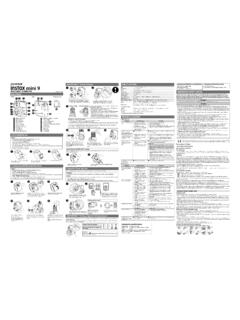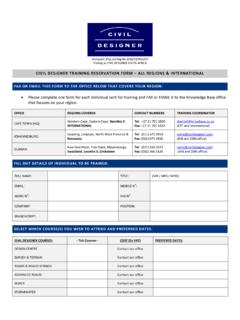Transcription of 2 QUALITATIVE AND QUANTITATIVE COMPOSITION
1 Page 1 of 19 NEW ZEALAND DATA SHEET 1 PRODUCT NAME EMEND 40 mg, 80 mg, 125 mg, and 165 mg capsule 2 QUALITATIVE AND QUANTITATIVE COMPOSITION Each 40 mg capsule contains 40 mg of aprepitant Each 80 mg capsule contains 80 mg of aprepitant Each 125 mg capsule contains 125 mg of aprepitant Each 165 mg capsule contains 165 mg of aprepitant Excipients with known effect Each 40 mg capsule contains 40 mg of sucrose. Each 80 mg capsule contains 80 mg of sucrose. Each 125 mg capsule contains 125 mg sucrose. Each 165 mg capsule contains 165 mg sucrose. For the full list of excipients, see section 3 PHARMACEUTICAL FORM 40 mg: A size #4 opaque, hard gelatin capsule with white body and mustard yellow cap with 464 and 40 mg printed radially in black ink.
2 Dimensions are overall length mm. 80 mg: A size #2 opaque, hard gelatin capsule with white body and white cap with 461 and 80 mg printed radially in black ink. Dimensions are overall length mm. 125 mg: A size #1 opaque, hard gelatin capsule with white body and pink cap with 462 and 125 mg printed radially in black ink. Dimensions are overall length mm. 165 mg: A size #0 opaque. Hard gelatin capsule with a white body and light blue cap with 466 and 165 mg printed radially in black ink. Dimensions are overall length mm. 4 CLINICAL PARTICULARS Therapeutic indications EMEND, in combination with other antiemetic agents, is indicated for the prevention of acute and delayed nausea and vomiting associated with initial and repeat courses of: highly emetogenic cancer chemotherapy (see Section ) moderately emetogenic cancer chemotherapy (see Section ).
3 EMEND is indicated for the prevention of postoperative nausea and vomiting. Page 2 of 19 Dose and method of administration PREVENTION OF CHEMOTHERAPY INDUCED NAUSEA AND VOMITING (CINV) EMEND (aprepitant) is available as capsules for oral administration. EMEND is given for 1 day or for 3 days as part of a regimen that includes a corticosteroid and a 5-HT3 antagonist. The package insert for the co-administered 5-HT3 antagonist ( , ondansetron) must be consulted prior to initiation of treatment with EMEND. 1-Day Regimen of EMEND The recommended dose of EMEND for the 1-day oral regimen is 165 mg orally 1 hour prior to chemotherapy treatment on Day 1 only. Recommended dosing for the prevention of nausea and vomiting associated with highly emetogenic cancer chemotherapy: Day 1 Day 2 Day 3 Day 4 EMEND 165 mg orally none none none Dexamethasone* 12 mg orally 8 mg orally 8 mg orally bid 8 mg orally bid 5-HT3 antagonist ( , ondansetron) See the package insert for the selected 5-HT3 antagonist for appropriate dosing information none none none * Dexamethasone should be administered 30 minutes prior to chemotherapy treatment on Day 1 and in the morning on Days 2 through 4.
4 Dexamethasone should also be administered in the evenings on Days 3 and 4. The dose of dexamethasone accounts for drug interactions. Recommended dosing for the prevention of nausea and vomiting associated with moderately emetogenic cancer chemotherapy: Day 1 EMEND 165 mg orally Dexamethasone* 12 mg orally 5-HT3 antagonist ( , ondansetron) See the package insert for the selected 5-HT3 antagonist for appropriate dosing information * Dexamethasone should be administered 30 minutes prior to chemotherapy treatment on Day 1. The dose of dexamethasone accounts for drug interactions. 3-Day Regimen of EMEND The recommended dose of EMEND for the 3-day oral regimen is 125 mg orally 1 hour prior to chemotherapy treatment (Day 1) and 80 mg orally once daily in the morning on Days 2 and 3.
5 Page 3 of 19 Recommended dosing for the prevention of nausea and vomiting associated with highly emetogenic cancer chemotherapy: Day 1 Day 2 Day 3 Day 4 EMEND 125 mg orally 80 mg orally 80 mg orally none Dexamethasone* 12 mg orally 8 mg orally 8 mg orally 8 mg orally 5-HT3 antagonist ( , ondansetron) See the package insert for the selected 5-HT3 antagonist for appropriate dosing information none none none * Dexamethasone should be administered 30 minutes prior to chemotherapy treatment on Day 1 and in the morning on Days 2 through 4. The dose of dexamethasone was chosen to accounts for Medicine interactions. Recommended dosing for the prevention of nausea and vomiting associated with moderately emetogenic cancer chemotherapy: Day 1 Day 2 Day 3 EMEND 125 mg orally 80 mg orally 80 mg orally Dexamethasone** 12 mg orally none none 5-HT3 antagonist ( , ondansetron) See the package insert for the selected 5-HT3 antagonist for appropriate dosing information none none * Dexamethasone should be administered 30 minutes prior to chemotherapy treatment on Day 1.
6 The dose of dexamethasone was chosen to accounts for medicine interactions. PREVENTION OF POSTOPERATIVE NAUSEA AND VOMITING (PONV) The recommended oral dosage of EMEND is 40 mg within 3 hours prior to induction of anaesthesia. Method of administration Capsules should be swallowed whole. General information See Section for additional information on the administration of EMEND with corticosteroids. Refer to the full prescribing information for co-administered antiemetic agents. EMEND may be taken with or without food. No dosage adjustment is necessary based on age, gender, race or Body Mass Index (BMI). No dosage adjustment is necessary for patients with severe renal insufficiency (creatinine clearance <30 mL/min) or for patients with end stage renal disease undergoing haemodialysis.
7 Page 4 of 19 No dosage adjustment is necessary for patients with mild to moderate hepatic insufficiency (Child-Pugh score 5 to 9). There are no clinical data in patients with severe hepatic insufficiency (Child-Pugh score >9). Paediatric patients The safety and efficacy of EMEND in paediatric patients have not been established. Contraindications EMEND is contraindicated in patients who are hypersensitive to any component of the product. EMEND should not be used concurrently with pimozide, terfenadine, astemizole, or cisapride. Dose-dependent inhibition of cytochrome P450 isoenzyme 3A4 (CYP3A4) by aprepitant could result in elevated plasma concentrations of these medicines, potentially causing serious or life-threatening reactions (see Section ).
8 Special warnings and precautions for use EMEND, a dose-dependent inhibitor of CYP3A4, should be used with caution in patients receiving concomitant orally administered medicinal products that are primarily metabolised through CYP3A4; some chemotherapy agents are metabolised by CYP3A4 (see Section ). Moderate inhibition of CYP3A4 by aprepitant, 125 mg/80 mg 3-day oral regimen or 165 mg single dose, could result in elevated plasma concentrations of these concomitant medicinal products administered orally (see Section ). Weak inhibition of CYP3A4 by a single 40 mg dose of aprepitant is not expected to alter the plasma concentrations of these concomitant medicinal products to a clinically significant degree.
9 The effect of EMEND on the pharmacokinetics of orally administered CYP3A4 substrates is greater than the effect of EMEND on the pharmacokinetics of intravenously administered CYP3A4 substrates (see Section ). Co-administration of EMEND with warfarin may result in a clinically significant decrease in International Normalised Ratio (INR) of prothrombin time. In patients on chronic warfarin therapy, the INR should be closely monitored in the 2-week period, particularly at 7 to 10 days following initiation of the 3-day regimen of EMEND (125 mg/80 mg) or administration of a single 165 mg dose of EMEND with each chemotherapy cycle or following administration of a single 40 mg dose of EMEND for the prevention of postoperative nausea and vomiting (PONV) (see Section ).
10 The efficacy of hormonal contraceptives during and for 28 days after administration of EMEND may be reduced. Alternative or back-up methods of contraception should be used during treatment with EMEND and for one month following the last dose of EMEND (see Interactions). Paediatric Use Safety and effectiveness of EMEND in paediatric patients have not been established. Use in the Elderly In clinical studies, the efficacy and safety of EMEND in the elderly ( 65 years) were comparable to those seen in younger patients (<65 years). No dosage adjustment is necessary in elderly patients. Page 5 of 19 Interaction with other medicines and other forms of interaction Aprepitant is a substrate, a weak-to-moderate (dose-dependent) inhibitor, and an inducer of CYP3A4.


















